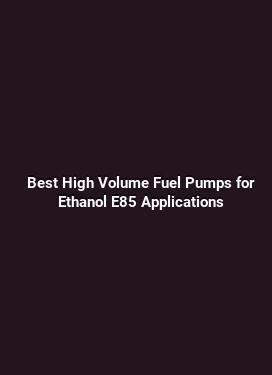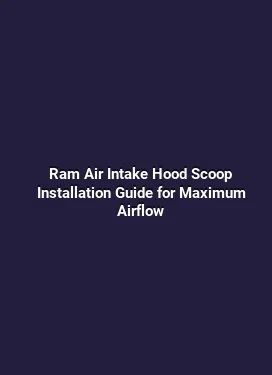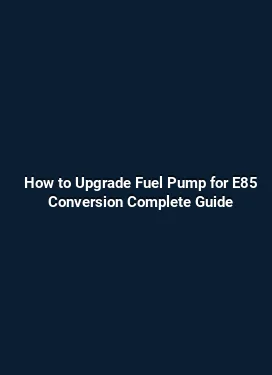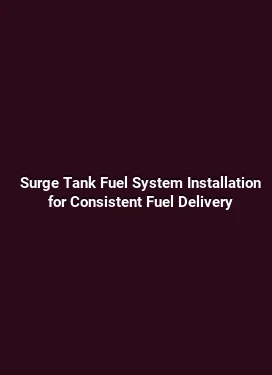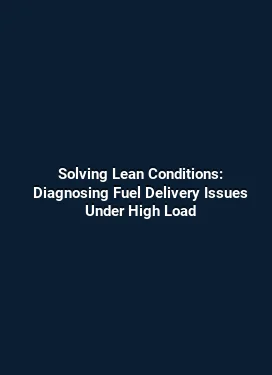Installing an E85 Flex Fuel Kit on a Turbocharged Nissan 370Z: A Practical Guide for Intake & Fuel Systems
Turbocharged V6 platforms like the Nissan 370Z offer exciting performance potential when combined with a flex fuel approach that can adapt to varying ethanol content. This guide dives into the intake and fuel system aspects of installing an E85 flex fuel kit on a turbocharged 370Z, covering components, plumbing, sensor considerations, calibration strategies, and real-world testing. The aim is to equip enthusiasts with actionable, safe, and repeatable steps that preserve reliability while unlocking additional horsepower and torque when ethanol-rich blends are available.
Foundational Considerations for Flex Fuel in a Turbocharged Setup

Adopting a flex fuel approach on a turbocharged engine starts with understanding how ethanol behaves under boost. E85 (roughly 51-85% ethanol, depending on climate and production) has a higher octane rating and different energy content than regular gasoline. In turbocharged configurations, ethanol’s cooling effect and varied stoichiometric targets influence timing, fuel trims, and air-fuel ratios. A robust kit should deliver precise fuel delivery, reliable sensor feedback, and a firmware path for safe operation across fuel blends and temperature ranges.
Key elements in the intake and fuel systems influence how well the engine responds to ethanol blends. On the intake side, the goal is to maintain consistent air delivery, minimize restriction, and ensure that the air-fuel mixture is well atomized before entering the combustion chamber. On the fuel side, the system must compensate for ethanol’s different stoichiometry and vaporization characteristics, especially under boost. A well-designed kit coordinates with the engine control system to adjust fueling in real time while preserving drivability and cold-start reliability.
System Integration and Safety Considerations

Safety-first planning involves verifying the integrity of the fuel rail, high-pressure lines, injectors, and connectors, especially under increased manifold pressure. The 370Z’s turbocharger creates higher pressure and temperature conditions that can accelerate wear if components are undersized or poorly sealed. Select a kit with corrosion-resistant materials, proper fuel line routing away from heat sources, and secure clamps that prevent leaks under vibration. A comprehensive wiring harness should include ground reliability and shielding to minimize electrical noise in sensor signals during high-load operation.
Intake System Upgrades: Breathing for Boost
The intake path sets the stage for how efficiently the engine can ingest air, which directly impacts turbocharged performance. When using E85, cooler intake air can help improve density, but the ethanol content also affects combustion dynamics and fuel demand. Upgrading the intake system involves selecting a high-flow air filter, a low-restriction intake pipe, and ensuring the intake tract interfaces cleanly with turbocharger housing or bypass routes.
In practice, a larger diameter intake with smooth bends reduces flow turbulence. A properly designed intake also minimizes heat soak by employing shielding or insulating components. When paired with a turbo system, even modest gains in intake efficiency translate to more consistent air density under varying boost levels. Pay attention to MAF (mass airflow) sensor placement and calibration because ethanol blends can alter sensor output characteristics. If the kit includes a tuned intake boot or silicone couplers, ensure the joints are air-tight and supported to prevent fatigue from engine movement under boost.
Sensorry and Airflow Feedback
Real-time airflow data is essential for stable operation with E85. The intake setup should preserve accurate measurements from the MAF sensor or alternative airflow sensing method, depending on the ECU strategy. For engines without a direct MAF replacement, a properly calibrated relocation for the MAF can help avoid misreadings caused by the turbo-induced pressure waves. Calibration might include adjusting actual versus indicated air mass to reflect ethanol's different air-fuel stoichiometry.
Fuel System Upgrades: Delivering Ethanol Consistency Under Boost
Fuel delivery is the core of an E85 conversion. Ethanol blends require careful consideration of injector sizing, fuel pump capacity, lines, and the fuel return path. Turbocharged engines demand higher fuel flow during boost, and ethanol’s lower energy density can necessitate larger injectors or multi-pulse strategies to maintain the same power output as gasoline. A flex fuel kit typically includes calibrated injectors, a high-flow fuel pump, necessary adaptors, and a dedicated fuel pressure regulator that can accommodate different blend ratios.
High-quality components reduce the risk of fuel starvation and maintain reliable rail pressure during shifts in boost and ethanol content. It’s crucial to verify compatibility with the 370Z’s fuel system layout, ensuring that pressure targets align with the ECU’s fueling strategy. Some kits integrate a blend sensor to measure ethanol content and feed this data into the ECU for dynamic adjustment. If your kit uses an external fuel pressure regulator, position it where heat exposure is minimized and lines stay free of kinks or sagging under vehicle movement.
Fuel Line Routing, Heat Management, and Safety
Ethanol can attract moisture and corrode certain metals over time. Selecting corrosion-resistant lines, clamps, and fittings extends system life. Route fuel lines away from exhaust components, turbo housings, and sharp edges that might abrade lines during maintenance or driving over rough roads. Consider a shield or heat sleeve for lines running near hot components to prevent softening or deterioration. An immovable cradle or bracket helps prevent line movement, which reduces the risk of leaks and reduces fatigue on fittings at high boost levels.
Tuning, Calibration, and Real-World Driving Scenarios
Calibration is the bridge between hardware and performance. With E85, fueling strategies adapt to ethanol content, air temperature, humidity, and boost pressure. The aim is to achieve stable idle, smooth throttle response, and reliable power delivery across a wide range of operating conditions. A practical approach includes staged validation: room-temperature idle tests, cold-start checks, low- to mid-load cruising, and then full-throttle testing at varying ethanol percentages.
During calibration, monitor parameters such as fuel trims, wideband oxygen sensor readings, and knock tendency. Ethanol-rich blends cool the intake and can reduce knock risk, but improper fueling can still lead to rich or lean conditions under boost. A robust kit should provide or be compatible with a tunable ECU map, allowing safe adjusting of timing and fueling as ethanol content varies. Realistic road testing should include sustained highway cruising, city stop-and-go, and spirited passes to confirm that the flex fuel system responds predictably to changes in blend ratios and ambient temperature.
Practical Calibration Steps
Begin with a base map tuned for gasoline, then progressively introduce E85 in staged blends. Use a wideband sensor to verify air-fuel ratios across RPM and load ranges, ensuring that you do not exceed a safe lean limit under boost. Enable a fuel trim strategy that compensates for ethanol content variability without sacrificing drivability. Pay attention to cold-start behavior since ethanol can stiffen starting characteristics in cooler conditions. A well-designed calibration relies on repeatable data collection and careful logging to identify any outliers or sensor drift that could compromise performance.
Durability, Longevity, and Maintenance
Durability is a major consideration when running a flex fuel kit on a turbocharged platform. Ethanol can be more corrosive to certain fuel system materials, and higher ethanol content can require more frequent inspection intervals for seals, filters, and O-rings. Regular maintenance should include checking fuel injectors for coating wear, inspecting hose clamps for tightness, and verifying that the fuel pump is operating within its specified pressure range. A proactive maintenance plan helps ensure reliability, reduces the chance of fuel leaks, and supports consistent performance across seasons.
Additionally, monitoring the health of sensors—especially the wideband O2 sensor and blend content sensor if installed—is essential. When operating at higher ethanol percentages, sensor drift can lead to erroneous fuel trims if left unchecked. Routine diagnostics, software updates from the kit manufacturer, and periodic recalibration after major climate shifts or maintenance work help preserve performance and safety.
Performance vs. Reliability: Finding the Balance
The goal is to enjoy the torque-rich character of a turbocharged 370Z without compromising reliability. A properly chosen flex fuel kit offers a robust warranty, high-quality components, and a clear maintenance path. While ethanol allows higher boost tolerances and improved cooling, the overall result hinges on a matched assembly of intake, fuel, sensors, and ECU calibration. Maintaining this balance ensures that the car remains a reliable daily driver while delivering increased performance on the track or during spirited weekend drives.
Real-World Installation Timeline and Milestones
For a typical installation, plan a multi-session approach. The first session focuses on hardware assessment, gathering all required parts, and routing fuel and intake lines. The second session covers sensor integration, exhaust howls and intercooler interactions, and securing all connections. The third session is dedicated to baseline startup and initial tuning iterations, followed by testing and refinement. Expect several test drives to confirm that the system responds predictably across fuel blends and driving scenarios.
Documentation and labeling are critical. Label all lines, anticipate future maintenance access needs, and store service data logs for future reference. When finished, perform a final inspection to confirm there are no leaks, clamps are secure, and electrical harnesses are properly shielded. A careful, methodical approach reduces post-installation headaches and helps you reap the full benefits of the E85 flex fuel upgrade on your turbo 370Z.


